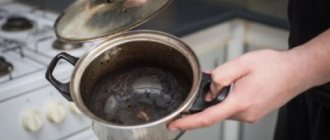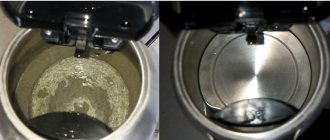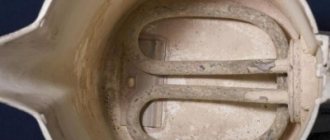The difficulty of removing it is due to the fact that it cannot be removed during normal dishwashing. To do this, you can use home recipes and special household chemicals.
Read the article about how and how to remove scale from a saucepan at home.
Top 3 special tools
If folk remedies are insufficiently effective, store-bought household chemicals designed to remove scale from dishes will come to the rescue.
Antiscale
The special product Anti-Scaling TM Zolushka (manufactured in the Russian Federation) is intended for removing lime deposits from the inner surface of teapots and pans. The exception is enamel cookware, for which this product is not intended.
Advantages of use:
- biodegradability;
- affordable price;
- Ease of use;
- non-toxic;
- efficiency.
Very easy to use:
- Pour cold or warm water into the pan.
- Dissolve the contents of the sachets based on the proportion - 1 sachet per 4-5 liters of water.
- Stir.
- Leave to stand for 20 minutes.
- Rinse.
In addition to pots, Antiscale can be used in electric kettles, regular kettles, and irons. The price per bag is less than 20 rubles.
Chistin Antiscale
The cleaning product produced in the Russian Federation is available in small packages of 75 grams. Chistin can be used to descale teapots, pots, irons, boilers, etc. The product is even suitable for cleaning enamel dishes.
To prepare the solution, dilute the contents of the package in 1 liter of warm (about +40°) water and leave for half an hour . After this, wash the pans with a sponge in running water. The cost of Chistina is about 40 rubles per package.
Romax Boom
The drug TM Romax Boom is available in 0.3 liter bottles. The product is suitable for stainless steel and glass, but cannot be used for cleaning enamel containers.
Application:
- Prepare a solution based on the ratio - 0.5 liters. water – 100 ml Antiscale.
- Pour the solution into the pan.
- Leave to stand without heating for about half an hour.
- Drain the liquid.
- Rinse the pan with water.
The product is produced in Belarus. A bottle costs about 45 rubles.
Clean the pan from carbon deposits inside and outside
During the cooking process, burnt pieces of food remain at the bottom of the pan, which form soot. Such pollution is fought with both folk remedies and a variety of household chemicals. Folk remedies do not cope with the task quickly, but they are also inexpensive. Household chemicals are more expensive, but they clean faster.
When choosing household chemicals, follow the instructions on the label.
The order of action of all chemicals is similar:
- carefully distribute the product over the stain and leave for 10–20 minutes;
- armed with a sponge, wipe off the carbon deposits;
- Rinse thoroughly with plenty of cold running water.
Attention! The composition of household chemicals is always aggressive, so work with them with gloves and a mask, in a ventilated area or outdoors. It is better to use chemicals only for the outer surface, and use folk remedies inside.
Folk remedies, for example, soda ash, are suitable for supporters of ecology and economy. Mustard powder in the proportion of 1 tbsp. l. water for 2 tbsp. l. powder eliminates unpleasant odors and dissolves fat. If you use mustard regularly, washing only takes a few minutes. A neglected pan will have to be rubbed longer and more than once.
They also clean dishes with wood ash - this is a popular country option. The cleaning result is excellent, but it’s better to do it outside. Another advantage of this tool is safety.
There is another old method that will help with any severe contamination. Add to 10 liters of water your choice:
- A bar of laundry soap (72%).
- Two tubes of silicate glue (sold in office supply stores). Can be replaced with liquid glass.
- Half a pack of soda ash.
Dilute everything in an iron basin or bucket, boil it and boil the available utensils in it for 10 minutes over low heat - from pots to spoons. Then rinse under running water.
Cleaning features depending on the material
When starting to descale pots, you should definitely take into account the material from which they are made. This circumstance cannot be ignored, since violation of the care rules can lead to damage to kitchen utensils.
Aluminum cookware
Aluminum pans, when regularly used for boiling high-hardness water, quickly lose their appearance. This material oxidizes and darkens when exposed to food and water.
For aluminum, good results will be obtained by boiling with brine, using solutions of citric or acetic acid, or using apple peelings.
The peculiarity of the material imposes a number of restrictions on cleaning such pans. All the “don’ts” when removing plaque from aluminum cookware:
- use products with chlorine;
- use abrasives (steel wool, soda, etc.).
Preparations that are intended for dishwashers cannot be used to treat aluminum, as they can react chemically with this metal.
How to remove from enamel?
Convenient and beautiful dishes coated with enamel also begin to become overgrown with lime deposits when water boils . At the initial stage, the salts that form the sediment have a loose consistency, but over time they become hard, worsening the appearance of the dishes.
Many methods are suitable for cleaning, excluding aggressive mechanical action and concentrated acids.
Can be used:
- brine,
- peeling potatoes,
- soda
Cookware with enamel defects on the inside should not be used for cooking.
Made of stainless steel
Stainless steel pans are durable, laconic, and last a very long time. These things are quite easy to take care of. But the problem of scale formation in relation to stainless steel is also relevant.
The ability of the material to withstand the effects of household chemicals allows for effective cleaning. You can use almost any recipe, including: citric acid, baking soda, vinegar, etc.
Basic rules for caring for pots
Removing scale often takes a long time, and dealing with contamination leads to damage and damage to the product. Experts recommend following preventive measures and minimizing the possibility of contamination, since it is always easier to deal with a light coating than with a persistent and neglected one.
- Careful and careful washing of any type of dishes and water filters are the best means of prevention. Forget about boiling tap water.
- Whenever possible, use spring or bottled water when cooking.
- Do not neglect regular cleaning of dishes and kitchen utensils (at least once a month).
- If boiled water has not been used, drain it. Do not reheat boiled water.
- After each use, rinse the dishes with water and wipe dry with soft cloths.
- When washing pots, avoid using any products containing abrasives. Do not use hard brushes or sponges.
- Avoid scratches and damage - such utensils are absolutely not suitable for cooking.
- In order to preserve the coating, eliminate possible temperature changes (hot to cold and vice versa).
To date, there are no known ways, methods and materials when it would be possible to accurately and permanently get rid of scale. But still, following simple recommendations and advice, promptly getting rid of the first signs of contamination, it is realistic and easy to achieve clean dishes and extend their life.
If you know interesting and effective recipes or are ready to reveal your secrets of caring for kitchen utensils, be sure to share them with us!
Prohibitions
In an effort to descale your pots as efficiently and quickly as possible, you need to remember a number of prohibitions when processing.
These include the following:
- Do not use chemicals that are not designed to care for cookware to clean the inside of the pan. Such experiments can not only damage the material of the pan, but also cause harm to health.
- You should also not try to speed up the process by using sharp and abrasive objects (sandpaper, knife, etc.) - the surface can be seriously damaged.
Upload to PMM or not
Enameled cookware can be trusted to a machine, but under certain conditions. It is necessary to select the appropriate mode (indicated in the instructions compiled by the manufacturer).
The housewife needs to take care of dishwashing detergents in the dishwasher. They must be soft and free of alkali and other aggressive chemicals.
Enameled utensils must be placed in the lower basket of the machine, as these are quite heavy utensils. Before loading the dishes, you first need to clear them of any remaining food.
You should not use conventional gels or products to wash enamel dishes. Choose only those intended for PMM.
Preventive measures: how to prevent the formation of lime deposits?
To reduce the possible likelihood of limescale deposits forming on pots and other utensils, it is advisable to use preventive measures.
These include:
- Using softened water for cooking. This can be achieved by installing a filtration system and using purchased purified water.
- After each cooking, the dishes must be washed thoroughly. In this case, plaque will not accumulate on the walls and bottom.
How to descale a saucepan with citric acid.
If the coating on the inside of the dishes is fragile and easily damaged, you can replace the aggressive vinegar essence with a softer citric acid. “Limonka” copes well with scale and does not affect the main coating of the pan.
- For the hot method, we need 20 g of acid per 1 liter of water. Bring the water to a boil and leave to stand for half an hour. If necessary, repeat the procedure.
- For the cold method, the concentration of citric acid will be required 1.5 - 2 times more. After several hours of “soaking”, the scale can be easily removed with a regular sponge.
Recommendations
Expert advice will help you effectively deal with lime deposits and keep this process under control:
- The intensity of sediment accumulation is directly related to the hardness of the water used.
- Sediment in the pan not only looks unsightly, but also negatively affects your health.
- Timely descaling allows the pan to heat up faster, since due to its physical properties, lime insulates heat, lengthening the cooking process.
- Before you start cleaning the pan, you need to make sure that the chosen method is safe for the coating.
- After cleaning scale using any method (even using food products, such as soda, vinegar, etc.), the surface should be thoroughly washed.
- Most products may not be able to cope with a thick layer of lime the first time. In this case, the procedure will have to be repeated several times.
Keeping your cookware clean not only inside but also outside will extend its life and keep your kitchen appliances hygienic.
This section will tell you about methods for cleaning various household appliances from scale.
Removing plaque from aluminum: 2 ways
Special means are not needed to remove scale from the walls of an aluminum pan. The following remedies are recognized as the most effective:
| Photo | Description |
| Method 1. Tooth powder The powder will do an excellent job not only of water marks, but also of soot, which often forms on the outside of the dishes. | |
| Method 2. Onion The onion must first be peeled. Onions cut into quarters are placed in a bowl, filled with water and cooked for 1–1.5 hours. |
It is important to remember that an aluminum pan cannot be cleaned with metal sponges. They will make it unsuitable for further use.
Fight scale with soda
Traditional carbonated drinks are also effective in combating limescale. This product is great for getting rid of scale on pots, kettles, coffee makers and even irons.
If you are afraid that the device will become colored due to contact with soda, use a colorless one. You can also use mineral water.
Get rid of deposits on a teapot or coffee maker using soda
First you just need to open a bottle of sparkling water and let it sit for a while. This is necessary to get rid of most of the carbon dioxide. Now the liquid can be poured into the device. Let sit for 25 minutes and then bring to a boil on the stove. When cleaning is complete, rinse the vessels thoroughly.
Remove scale from the iron
Soda must be poured into the water tank. Then turn on the iron and keep it in an upright position. At the same time, it is necessary to let off steam. If the scale is too strong, the procedure will have to be repeated several times.
Cleaning a pan from deposits using soda You need to pour carbonated water into the pan and put it on the stove. Let it boil and remove from heat. It is recommended to leave it to steep overnight. Such manipulations will allow you to easily remove scale.
Why is enamel destroyed and what should not be done?
Practical tips will help to keep enamel utensils tidy:
- It is forbidden to put empty dishes on the fire;
- a container with water cannot be placed in the freezer - expanding, the water causes damage to the enamel;
- impacts from falls are fraught with chips that quickly become covered with rust;
- It is not recommended to use metal brushes and brushes for regular cleaning - they damage the coating;
- It is undesirable to use metal spatulas, spoons, or whisks when stirring food - they scratch the surface;
- It is not recommended to place enameled products on a gas burner without a flame divider (due to spot heating, the enamel layer quickly becomes unusable);
- Dishes with enamel cannot withstand sudden changes in temperature, so you cannot take a hot container out into the cold or, conversely, put a cold pan on the fire right away.
Causes of sediment on enamel pans
If you do not remove scale as soon as it appears, it will soon form a thick layer on the walls of the pan. Plaque on the walls of the pan is formed as a result of the accumulation of sediment. The quantity and quality of microelements in the liquid affects the density and thickness of the scale. Hard water contains many elements that are activated when heated. Interacting with each other, the substances begin to penetrate into the coating. You need to remove scale from the pan carefully, without destroying the enamel itself.
At first, the water deposit is invisible, but if it is not removed immediately, the layer will become thicker over time. When the enamel is severely damaged, scale begins to accumulate in cracks and microchips. It is almost impossible to remove such pollution or prevent its occurrence. Plaque can have a detrimental effect on the coating of dishes and human health.
If the sediment is not removed for a long time, and the layer of contamination reaches several millimeters, even a mild impact will damage the enamel. Therefore, you need to carefully monitor your kitchen utensils.











